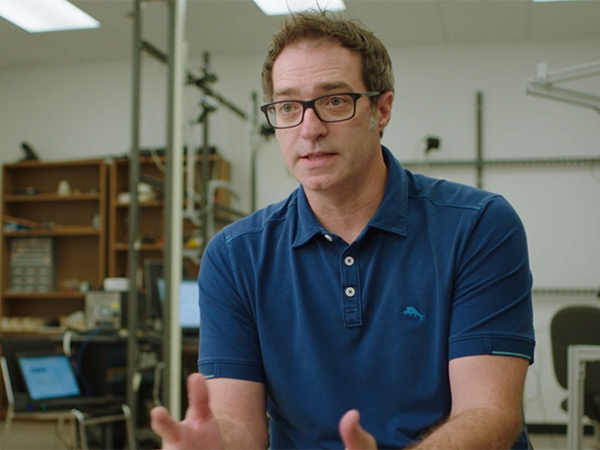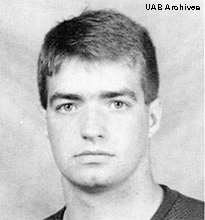When William “Jamie” Tyler chose to attend UAB as an undergraduate in the 1990s, he was motivated by a chance to be part of something brand new—a fledgling NCAA football program.
Now, more than 30 years after showing up as a freshman offensive lineman, Tyler is returning to UAB, and once again, he says his motivation is all about being part of something entirely new. “Neuroengineering,” Tyler said when asked about his decision to return to UAB. “As soon as I heard UAB was starting a neuroengineering Ph.D. program, it was a no-brainer.”
 William “Jamie” Tyler, Ph.D., grew up in Pelham and still has family in the Birmingham and Nashville areas. While Birmingham and UAB have changed dramatically over the past 30 years, Tyler says the biggest surprise to him has been the things that haven’t changed. “My biggest shock was that places like the Pita Stop are still here. I always knew UAB was going to grow and transform, so that’s not surprising. You have all these new buildings and changes that could have made the place unrecognizable, but then there are these familiar small businesses that have survived and are still thriving.”Tyler, a two-time graduate of UAB, officially joined the faculty earlier this year as the School of Engineering’s first strategic hire in Neuroengineering. The school is hiring faculty across multiple departments to address neurogenerative diseases such as Alzheimer’s and Parkinson’s Disease, disability arising from spinal cord injury and stroke, and other important medical problems using engineering technologies such as brain-computer interfaces, artificial intelligence, and neuromodulation.
William “Jamie” Tyler, Ph.D., grew up in Pelham and still has family in the Birmingham and Nashville areas. While Birmingham and UAB have changed dramatically over the past 30 years, Tyler says the biggest surprise to him has been the things that haven’t changed. “My biggest shock was that places like the Pita Stop are still here. I always knew UAB was going to grow and transform, so that’s not surprising. You have all these new buildings and changes that could have made the place unrecognizable, but then there are these familiar small businesses that have survived and are still thriving.”Tyler, a two-time graduate of UAB, officially joined the faculty earlier this year as the School of Engineering’s first strategic hire in Neuroengineering. The school is hiring faculty across multiple departments to address neurogenerative diseases such as Alzheimer’s and Parkinson’s Disease, disability arising from spinal cord injury and stroke, and other important medical problems using engineering technologies such as brain-computer interfaces, artificial intelligence, and neuromodulation.
To train future neuroengineers, UAB has also launched a joint Ph.D. program between the UAB Schools of Engineering and Medicine. While there were many factors that made the move to UAB attractive, Tyler says it was the opportunity to get in on the ground floor of the neuroengineering doctoral program that was most intriguing. “UAB has always been strong in basic neuroscience, but I stopped doing neuroscience a decade ago and started doing things that are more accurately described as neuroengineering, which is much more applied science,” Tyler said. “There just aren’t a lot of formal academic settings concentrating on this type of work, so this is definitely a unique opportunity. The fact that it is a move home for me and closer to family is a bonus.”
UAB’s Neuroengineering Ph.D. Program is a novel standalone program that spans the participating Schools rather than being housed in a single department. That unique nature reflects the highly collaborative and multidisciplinary environment at UAB, which creates opportunities to lure the nation’s top innovators like Tyler. “Jamie’s pioneering work using ultrasound to modulate brain and nerve function has opened up tremendous opportunities for treating a wide array of conditions,” said School of Engineering Dean Jeff Holmes, M.D., Ph.D. “We were able to offer him appointments across three departments in three different Schools here at UAB, so that he can work directly with clinicians to realize the full potential of the therapies is developing. The interdisciplinary and pioneering nature of his work, together with the fact that he is a graduate of UAB, made Jamie the perfect person to be our first Neuroengineering faculty hire.”
Part-Time Academic, Full-Time Innovator
In truth, Tyler’s work has never fit comfortably in an academic setting. After earning a Ph.D. in neuroscience from UAB in 2003, Tyler went on to do a postdoctoral fellowship at Harvard University. Over the past decade, he has held faculty positions at Arizona State and Virginia Tech, but during that stretch, his began to split his time between the academic and business worlds as he began to do pioneering work in the field of neuromodulation.
“I’m mostly known for discovering that you can use low-intensity pulse ultrasound to modulate brain activity non-invasively, which is what we call neuromodulation,” he said. “Everything we knew about the brain before was electrical and biochemical. But you see changes to the brain all the time when people get knocked unconscious from being hit in the head. There is no electrical charge transfer, no chemical intervention. They just get knocked out. So I was curious about how mechanical waves might affect brain activity, and I couldn’t find anything on it.”
To be fair, Tyler was not the first to use ultra-sound technology on the brain. But previous efforts involved high-intensity ultrasound waves to heat up the brain and literally burn parts of the brain away. “I was interested in what happens if you use that same technology at low intensities,” Tyler explained. “Instead of burning away brain tissue, can you just shake the synapse a little bit and get it to change its activity?”
The answer, it turned out, was yes. And with that discovery, Tyler’s immersion in the business world began. In 2008, he founded SynSonix, a company that developed neuromodulation technology for the control of post-traumatic pain. In 2011, he joined Virginia Tech, where he established a neuroengineering research team to develop neuromodulation methods and systems. Later that year, he established a second company, Thync.
To date, Tyler has founded five different companies that have spun out of his research, and he has 45 patents. In 2014, Tyler returned to Arizona State as a part-time faculty member while still running a company from Boston. He later would move to ASU full time to found and direct a public-private partnership called the WearTech Applied Research Center, which fostered the development and commercialization of wearable technologies.
Cross-Disciplinary Nature
That union at Arizona State between academia and entrepreneurship was a natural fit for Tyler, but he says historically, that sort of arrangement is rare—except at UAB.
“It used to be that academics and entrepreneurship didn’t mix,” he said. “You either did one or the other. But UAB is different. Even when I was a student here in the 90s, there was an energy here that came from scientists working together across disciplines.”
Few faculty members represent that cross-disciplinary potential better than Tyler, who holds positions in three different schools at UAB. In addition to being the first Neuroengineering faculty hire, Tyler is a professor of Biomedical Engineering (Schools of Engineering and Medicine), Physical Medicine and Rehabilitation (School of Medicine), and Occupational Therapy (School of Health Professions).
He is also Co-Director of the UAB Center for Engagement in Disability Health and Rehabilitation Sciences (CEDHARS), as well as the center’s Director of Innovation.
“It is very exciting to have Dr. Tyler here at a time when he can be involved in so many different facets of our academic and research enterprise,” said Lynn Dobrunz, Ph.D., Professor of Neurobiology, Co-Director of the Neuroengineering Ph.D. program, and Director of the Neuroengineering and Brain-Computer Interface Initiative. “I knew him when he was a graduate student, and I was aware of the success he has had over the years since leaving UAB. His background makes him an ideal fit for UAB Neuroengineering because he is a scientist who has experience bridging those gaps between research, product development and commercialization.”
At UAB, Tyler’s roles in the Schools of Medicine and Health Professions will allow him opportunities to interact with patients who benefit from his work. That interaction is something Tyler says will be essential to his work, but also welcomes the opportunities to interact with faculty and students from across campus.
“In many ways, neuroscience forces you to be multi-dimensional and cross disciplinary,” Tyler said. “Even when I was an undergraduate, neuroscience was this weird mix of different fields like engineering, mathematics, computer science and biology. In a way that molded me as a neuroengineer, because I wasn’t an engineer and I wasn’t a biologist. I was making my own path.”
Now that that path has brought him full circle to UAB, Tyler says he looks forward to shaping new generations of explorers and entrepreneurs. “Some universities seem to discourage entrepreneurship, but they want more of that at UAB. I believe this is an institution where I can spend the rest of my career giving back and helping other faculty be more entrepreneurial.”
Vagus, Baby!
From Gridiron Dreams to a Career Helping Athletes Find Focus
 Jamie Tyler’s academic and entrepreneurial success would make any university proud. But the fact is that Tyler’s decision to attend UAB had little to do with academics, and everything to do with football.
Jamie Tyler’s academic and entrepreneurial success would make any university proud. But the fact is that Tyler’s decision to attend UAB had little to do with academics, and everything to do with football.
“I came here to play college football,” said Tyler, who played offensive line in the early 90s under Blazer Hall of Fame Coach Jim Hillyer, Ph.D. “It was just luck that UAB was developing one of the top neuroscience programs in the nation, because I would have gone anywhere for the chance to play football. UAB was starting its first official year of football in 1991, and I knew some of the coaches, so that’s why I chose UAB.”
Even though his main motivation was football, Tyler deviated from the stereotypical jock route by spending two years of his undergraduate career investigating the influence of intestinal cholecystokinin octapeptide (CCK-8) on CCK Type-B receptors to regulate satiety. He went on to earn a Ph.D. in neuroscience from UAB, but his interest in athletic performance was far from over.
In addition to his pioneering work in neuromodulation, Tyler has also worked with athletes and with the U.S. Department of Defense on projects that involve electrical stimulation of the brain’s cranial nerves to modulate arousal, tension, and sleep-wake cycles, to name a few.
“When you look at factors that have an impact on performance or what drives disease, it often comes down to stress and lack of sleep,” Tyler said. “We have found that by putting a stimulating device inside the ear, you can affect the Vagus nerve in a way that removes distractions and allows athletes to focus. Other researchers have achieved similar results using implants or handheld devices that you press against the side of the neck. But for our purposes, we wanted the subjects to have free use of their hands, so we chose earbuds. They had the added benefit of already being familiar, so there is a level of comfort there.”
Learn more at Tyler's Lab site